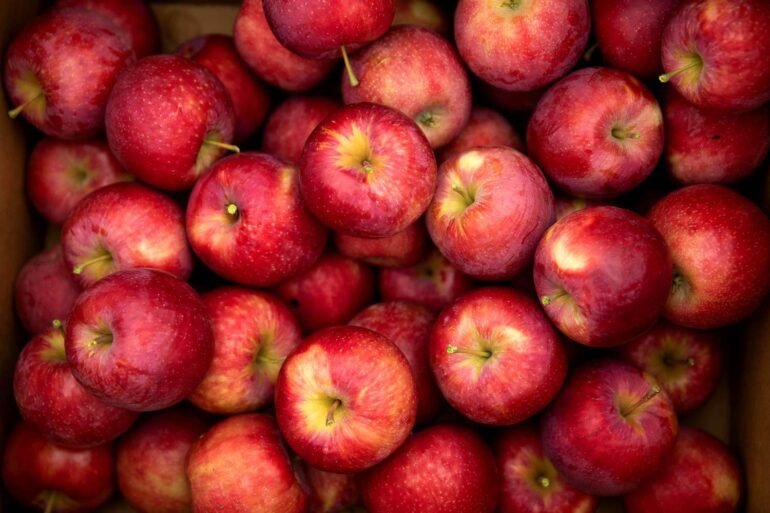:max_bytes(150000):strip_icc():format(jpeg)/New-Apples-2025-FT-DGTL1025-Kudos-02-dc287e4b068e41d5903dd21532990b78.jpg)
When surveying the dozen-plus apple varieties on display at the supermarket, it’s easy to forget that we modern consumers weren’t always so spoiled for choice in the apple department.
Apples have a rich diversity throughout history and around the world, including in the United States. But the current selection is thanks largely to the Honeycrisp apple, the juicy, crisp, and tart-sweet household name that was saved from the rejection pile of the University of Minnesota’s (UMN) apple breeding program in 1982 by a young horticulturalist named David Bedford.
Craig Kahlke, fruit quality management specialist at Cornell University
“Honeycrisp was definitely a game changer. People actually got excited about apples.”
— Craig Kahlke, fruit quality management specialist at Cornell University
A beloved name since the early 2000s, Honeycrisp and its snappy crunch have been hugely influential on the abundance of varieties that now grace the produce section. But do any of these newcomers have what it takes to dethrone the mighty Honeycrisp?
“Nothing can dominate forever,” says Bedford, now a senior research fellow in his 46th year at UMN. “Even the best of anything at some point gets moved aside or shares the spotlight.”
Bedford was fresh out of graduate school when he joined UMN’s apple breeding program in the early 1980s. At the time, Red Delicious and Golden Delicious dominated the apple market, though a hard, tart newcomer called Granny Smith had reopened consumers’ minds to the possibility that apples weren’t just sweet, mealy, and bland, says Bedford. When he came across a then-unknown clone called MN 1711 that was marked for removal, Bedford decided to give it another shot, believing it had been planted in a poor location under suboptimal conditions. Then it bore fruit.
“It was very different, with a texture unlike any other I’d had,” Bedford says, recalling it being “explosively” crisp. “My mind was reeling: ‘Did this get mixed in with Asian pear?’”
Honeycrisp was officially released in 1991 and hit supermarket shelves five years later. Since then, it has been named the official state fruit of Minnesota, and is one of the most widely planted and top-selling apple varieties in the U.S. It set the bar for premium-priced apples — though it’s also notoriously tricky to grow.
“Honeycrisp was definitely a game changer,” says Craig Kahlke, fruit quality management specialist and team leader of Cornell Cooperative Extension’s Lake Ontario Fruit Program. “People actually got excited about apples.”
Courtesy of CFANS / University of Minnesota
The vast majority of new breeds now coming to market, mostly from the research labs at three major university-based programs — Cornell, UMN, and Washington State University (WSU) — have Honeycrisp as one of their parents (including all five hopefuls below). Now with market-assisted breeding and technology and higher-density (aka closer-together) planting, new varieties are crossed and brought to market on a much quicker turnaround — down from 30 to as few as 15 years.
“There are so many new varieties coming out every year, and with all of the old ones still hanging out on the shelves it can be very intimidating to choose,” says Ben Heusinkvelt, grounds and orchard manager at Arbor Day Farm in Nebraska City, Nebraska. “In fact, I’ve heard from marketing agencies and fruit distributors both that the desire for newer…varieties is beginning to dwindle.”
Do any new varieties — from SnapDragon to Cosmic Crisp to the red-fleshed Lucy — have what it takes to be the next Honeycrisp? We tapped growers, marketers, and breeders to help us choose five contenders.
SnapDragon
Availability: New York
nancykennedy / Getty Images
Cornell developed SnapDragon — a cross between Honeycrisp and an unnamed New York apple variety — which sports intense crunch and juicy sweetness with traces of vanilla.
“We have a winner in Snap,” says Kahlke. “It has a good crunch, good sweetness, and also has acid in it so you do get that apple flavor; it’s not pure sugar like a Fuji apple.”
Exclusively grown and distributed by New York–based Crunch Time Apple Growers, SnapDragon is a managed or club apple, meaning it is licensed to a limited number of growers for consistent quality. One of them is Fishkill Farms in Hopewell Junction, New York, which grows some 80 apple varieties on 40 acres.
“It’s been a great year,” says Josh Morgenthau, owner and third-generation grower at Fishkill. “We’ve had a really nice, relatively cool growing season so the flavor of the apples is really wonderful.”
Given Snap’s regional limitations, however, Bedford considers it more of a midlevel, regional contender in the contest to unseat Honeycrisp. Morgenthau wonders if that’s such a bad thing.
“An apple is going to taste completely different if coming right out of a local orchard or picked a few weeks ago than coming out of deep, controlled-atmosphere storage for 10 months,” Morgenthau says. “So I think there hopefully will be more of a regional apple scene going forward.”
Kudos
Availability: Midwest
Courtesy of CFANS / University of Minnesota
Kudos is another child of Honeycrisp, this time crossed with the bright and brown-sugary Zestar (which makes Kudos a sibling to the popular 15-year-old SweeTango apple). This apple has a bright red skin and very white flesh with a crisp and juicy texture. Bedford describes the flavor as almost tropical fruity when fully ripe. Kudos was released by UMN for propagation in 2022, but Bedford doesn’t think it will be widely grown in larger apple-growing regions like Washington, meaning it might only compete seriously in Midwestern markets.
“It will probably never make it to big grocery stores, but I think regionally that will become a favorite in time,” he says.
Lucy
Availability: nationwide
Courtesy of Chelan Fresh
You’ll know it when you cut it open: Lucy has striking reddish-pink flesh, a result crossing Honeycrisp and Airlie Red, another red-fleshed apple. Lucy first became commercially available in 2019 and is credited to Bill Howell, an apple breeder and former research technologist in plant virology. This crunchy apple tastes sweet and tart. Its rosy interior, shot through with a bit of white, resists browning.
This apple actually comes in two types: Lucy Glo and Lucy Rose. Lucy Glo is notably tangy with a sweet finish and yellow-hued skin, while Lucy Rose offers sweet berry notes along with a deep red exterior that has speckles of white, according to Chelan Fresh, the Chelan, Washington-based fruit company and grower that produces Lucy apples. Trader Joe’s began stocking the apples in November 2024 and customer reviews have been mixed but generally positive, especially for the Lucy Glo. A few generations in, Bedford still finds red-fleshed apples to be more of a party trick than a serious contender with enough desirable traits to become mainstream.
“Sometimes they hit the market almost before they’re ready for primetime,” he says. “They can sustain themselves for a while because they’re a novelty. Who am I to say what the best apple is? I have my opinion.”
EverCrisp
Availability: Midwest, Plains, Northeast, Southeast
Bastiaan Slabbers / NurPhoto via Getty Images
A Honeycrisp and Fuji cross, EverCrisp was developed by the Midwest Apple Improvement Association (MAIA) and released in 2012, making it the oldest newcomer on the list. EverCrisp delivers serious crunch and big juice and is naturally slow to brown, making it a standout for snacking, meal prep, and cheese boards. However, as a naturally red-green (aka bicolor) apple, it doesn’t fit the “perfect ruby red” mold many shoppers look for at retail, according to Tenley Fitzgerald, head of marketing at Yes! Apples, a network of 50 New York–based small family farms that grow 20-plus apple varieties.
“That’s why we’re leaning into an ‘ugly delicious’ story — encouraging consumers not to judge an apple by its skin,” Fitzgerald says. “EverCrisp might not always look picture-perfect, but the flavor delivers every single time.”
It may be an uphill climb, as consumers tend to make decisions with their eyes first, especially when branching out to something new. Indeed, Heusinkvelt has found that varieties like EverCrisp tend to perform best in a U-pick setting, which “offers people a chance to try a new apple without committing to an entire bag of them at the store,” he says.
“They’re able to taste them and see if they like them, as well as see how they are grown and what they look like on the trees,” Heusinkvelt adds. “I think this helps sell them not only here at the orchard, but hopefully people go into their grocery stores and if they see them on the shelf they’ll be more likely to buy them again.”
Cosmic Crisp
Availability: nationwide
Courtesy of CosmicCrisp.com
Developed by WSU’s tree fruit breeding program, Cosmic Crisp crosses Honeycrisp and the late-ripening Enterprise apple from Washington. This large, juicy, tart, and sweet apple sports Honeycrisp-like crunch with a bit more density. It was bred with higher levels of acidity and sugars, which makes it a good baking and slicing apple that’s slower to brown when cut. Volume-wise, it’s a serious contender, as Washington state has led the country in apple production since the 1920s and grows about 60% of the nation’s apples, according to the United States Department of Agriculture (USDA).
“What Cosmic Crisp has going for it is that the mega apple production force has bought into that, hoping it will be a replacement for Honeycrisp,” Bedford says. “Growers can produce more efficiently out there. They’ve planted millions of these trees within the last five to six years. This is a tsunami that’s coming onto the marketplace.”
If Heusinkvelt had to pick a winner, it too would be Cosmic Crisp, which is “holding its own” in stores. “In the end, if your apple looks pretty and has a sweet, juicy crunch to it, that might make it the new best thing,” he says.
Maggie Hennessy
2025-10-07 10:00:00

